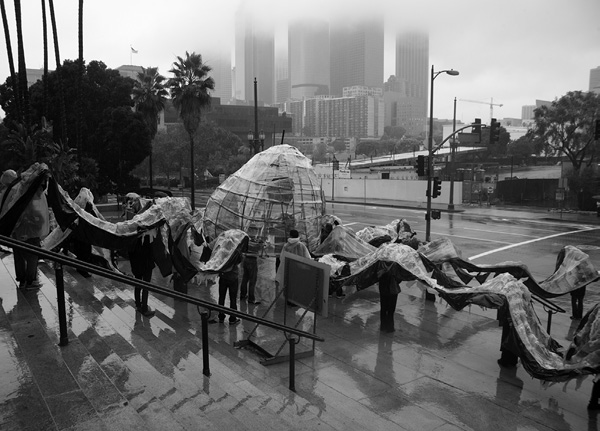
OCTUPY
first performed on
November 20, 2011
City Hall, Los Angeles, CA
performed twice in 2011
OWEN DRIGGS
Los Angeles, CA
899018891o899018891w899018891e899018891n899018891d899018891r899018891i899018891g899018891g899018891s899018891@899018891g899018891m899018891a899018891i899018891l899018891.899018891c899018891o899018891m
performingpublicspace.org
OCTUPY
OWEN DRIGGS
Organized by artist duo Owen Driggs, “Octupy” entailed the construction and performance of a giant octopus puppet at Occupy Los Angeles (OLA). The 70ft long, 20ft tall puppet is made of bamboo, bicycle inner tubes, plastic shopping bags, and parcel tape. On Sunday, November 20, in driving rain, forty puppeteers wound the creature around Los Angeles City Hall to “make the corporate tentacles visible.” “Octupy” undulated again, this time with such telling accessories as a money-stealing hand and the “Hammer of Foreclosure,” on January 2, 2012 as part of Occupy The Rose Parade.
For at least two centuries, political cartoonists have employed the octopus as a visual metaphor to clarify the deliberately obfuscating operations of power. The puppet emerged from a discussion at OLA about the role that rapacious California-based corporation Southern Pacific Railroad (aka “the Octopus”) played in cementing the foundations of corporate personhood. The six-week process of making “Octupy” in public, along with other occupiers and interested passers-by, supported multiple conversations about the histories and tactics of repression and resistance. At the same time, the nature of the octopus-an infinitely graceful creature with an apparently distributed consciousness-provoked discussion of the cephalopod as a visual metaphor of the Occupy movement’s horizontal power relationships and leaderless (leaderful) organization.
Described by artist and writer Matias Viegener as “a public toy” that engages “serious play,” “Octupy” is both a literal depiction of rapacity crafted from the refuse of stimulated desire and an experience of numerous tensions in action. Tensions, for example, between an artificial corporate body and the many natural human bodies that operate its representation; between a three-dimensional image of manipulating “other” and the experience of being a manipulator; and between hierarchical authoritarian power relationships and the puppeteers’ experience of collaborative process. The latter friction became particularly apparent during the second outing of “Octupy,” when-swirling into view on a sea of puppeteers and protestors-the trash-bag giant followed the Rose Parade’s official, largely corporate-funded floats. It was itself followed by three military-style trucks carrying police in riot gear. Performing between disneyfied homages to consumption and the militarized tools of state control, “Octupys”’s untidy foam of people and plastic challenged both.